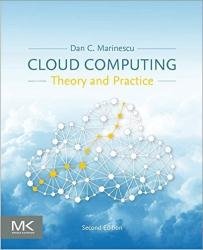 Название: Cloud Computing: Theory and Practice, 2nd Edition
Название: Cloud Computing: Theory and Practice, 2nd EditionАвтор: Dan C. Marinescu
Издательство: Morgan Kaufmann/Elsevier
Год: 2018
Страниц: 588
Язык: английский
Формат: epub
Размер: 44.4 MB
Cloud Computing: Theory and Practice, Second Edition, provides students and IT professionals with an in-depth analysis of the cloud from the ground up. After an introduction to network-centric computing and network-centric content in Chapter One, the book is organized into four sections. Section One reviews basic concepts of concurrency and parallel and distributed systems. Section Two presents such critical components of the cloud ecosystem as cloud service providers, cloud access, cloud data storage, and cloud hardware and software. Section Three covers cloud applications and cloud security, while Section Four presents research topics in cloud computing.
Specific topics covered include resource virtualization, resource management and scheduling, and advanced topics like the impact of scale on efficiency, cloud scheduling subject to deadlines, alternative cloud architectures, and vehicular clouds. An included glossary covers terms grouped in several categories, from general to services, virtualization, desirable attributes and security.
The text of the book is written in a straightforward and understandable way, drawing from hundreds of sources. The material and jargon from these sources are organized and presented in a common terminology, context, and framework to make them coherent.
This book is a comprehensive encyclopedia for cloud computing. In addition to the topics mentioned above, here is a sampling of other topics readers will learn about from this book, all in the context of cloud computing: application development, big data, containers, control theory for optimizing system use, data storage, data streaming, deadlock prevention, energy efficiency, graphics processing units, hypervisors, interclouds, interconnection networks, internet communications, MapReduce programming, mobile computing, network-centric computing and network-centric content, parallelism (data-level, thread-level, and task-level), performance analysis, process coordination, resource management and scheduling, security, service level agreements (SLAs), trust, virtualization, and warehouse-scale computers. Also in the book are surveys and comparisons of existing cloud computing hardware and software systems.
There is an extensive bibliography of over 500 publications. These are cited under each of the topics in the book and leads readers to more details. The references are often also used in the problems and exercise to help the reader learn more.
The book is well-organized, consisting of three main sections, each with multiple chapters. The book has great technical depth, addressing both underlying theoretical concepts and practical real-world issues. Even though the book is technically deep, the writing style and organization make it easy to follow and understand. There are over 180 figures, with meaningful lengthy captions, that are constructed in a way that is clear and comprehensible to support the information presented in the text.
Cloud computing infrastructures are large-scale complex systems that need to be designed, analyzed, deployed, and made secure in a manner that supports users' needs and provides a financial profit to the cloud services providers. These are very difficult problems, and approaches to handling these problems are presented throughout the book.
The software stack for cloud computing has evolved in the quest to provide a unified higher-level view of the system, rather than a large collection of individual machines. Virtualization and containerization are ubiquitous abstractions that allow easier access to the increasingly larger and diverse population of cloud users. Distributed and semi-structured storage systems such as Google's BigTable or Amazon's Dynamo are widely used. The pleiad of systems supporting higher level abstractions include FiumeJava, Mesa, Pig, Spark, Spark Streaming, Tachyon, and others.
Скачать Cloud Computing: Theory and Practice, 2nd Edition